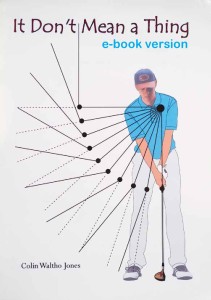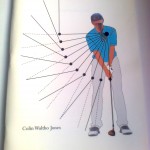Well done. Excellent play. 35 points (with a blob) and 5th place in a field of 87. You can only get better. Even though there will be minor ups and downs in your progress the trajectory will be upwards simply because we are genetically programmed to get better at physical acts as long as we let it happen and as long as we are motivated and as long as we keep repeating the same physical act (cf: eating); so to keep on getting better you just need to carry on playing golf and enjoying it: how nice is that?
———————————————————————–
I quote: “Caught my approach slightly heavy and it came up short of the green. I was trying to hit a knock-down wedge or ¾ wedge.” Please forgive me but just what is a “knock-down wedge”? I won’t go over again the danger to your subconscious processes of consciously choosing your shots from your back catalogue of “named” shots (I think the last one was a: “low-ish 7-iron” into the 18th green) that you have stored from listening to too many know-alls and reading too many magazines. There is no such thing as a “knock-down wedge” or any other kind of wedge. You had 60yds to the pin; there were a set of conditions to be aware of. You “feel” the 60yds; you don’t give it a bloody name! Based on your visualisation of the shot you choose the club and play the shot. THEN you can call it something, if you absolutely have to! The 3 putts were a virtual inevitability.
—————————————————————————-
This hole started with two belting shots and finished with 4 poor ones. The run of poor ones started with a poor pitch, for which you make an excuse. (Sorry, but there really is no reason on God’s earth why a new fairway would have any effect. Mo Norman could chip off concrete!). My concern is that your last pitch (at the 10th) was poor and it was described by you as a “knock-down wedge”. Then, at your next attempt at a pitch you hit another poor shot and this was after just having hit two very good ones. The sequence of events suggests that instead of simply playing the pitch with the rhythm of the preceding shots, you were looking to play a certain type of pitch. In doing so, not only do you play a poorer shot than you would wish (for the reasons mentioned above) but you also disturb the passing of the rhythm from one shot to the next. Your putting is then put under more pressure because the rhythm you need is NOT the last one you used, if you see what I mean.
——————————————————————————
[40. Winning through the fog” ]
There are two crucial moments in the pre-shot routine that can easily be missed if your conscious mind is at all distracted. The first critical moment is the moment that you decide to begin the routine. In the hurly-burly of getting to the tee – getting out the drivers, marking the cards etc – this important switch of concentration can easily be missed, especially on a familiar hole under familiar conditions.
The second moment is the moment you need to switch from visualising the shot to “re-igniting” the rhythm. This moment is critical if you are going to locate perfect “timing” and hit the drive with the same exquisiteness with which you have just hit that putt. This second moment is the one that requires your conscious brain to be operating in a space free from anxiety and other distractions. The message from your conscious to your subconscious needs to be vivid and sharp: perfect “timing” – and, therefore, beautiful golf shots – does not happen when there is a lot of “mind fog” around.
I think that was all worth . . .
—————————————————————————-
To begin, I want to remind you of the basis of what I am saying.
To hit or throw something so that it moves from position A to desired position B, is an incredible skill and barely believable when one considers all the complicating factors. Nevertheless, humans have this ability and games have evolved to test it in a measurable way under all sorts of conditions.
At the very heart of our ability to hit and throw accurately is the phenomenon that is generally known as “timing”. It is a phenomenon that is experienced by all games players and can be described as that feeling you get when the shot has done exactly what you wanted it to do and with the minimum effort. It is characterised by a feeling that the shot is going to be perfect even before contact has been made with the ball. The shot feels effortless and completely controlled. From a thunderous drive to a deft chip, the amount of power exerted feels precise. In short, “timing” is what makes playing games worthwhile.
I discovered the secret of “timing” in . . .
—————————————————————————————-
Lesson – I want to clarify my thinking to you about orthodox golf teaching. Basically, I have no opinion as to its merits because it exists to do what people want from it. That is, it operates in a market and so one can safely assume that whoever is paying for it must be getting some value from it.
I think that a better description of what I do is that I enable you to find out for yourself how to enjoy playing golf. I do this by giving you the one piece of information you are missing: “the key to the door”, as it were.
This key piece of information is that we apply accurate force to a golf ball by harnessing gravity through the double-pendulum that is our golf swing. With it comes the startling realisation (which is, in effect, my unique insight) that it is impossible to swing like a pendulum when you have to start the swing from a standing position behind the ball. (This insight explains why the world divides into natural players and hackers. Our first attempts at swinging at a golf ball with a golf club will almost certainly involve us accelerating away from the ball – instead of decelerating – simply because we will start the swing from behind the ball with the clubhead motionless: and you can’t decelerate from a standing start!)
Of course, you also have to accept that . . .


